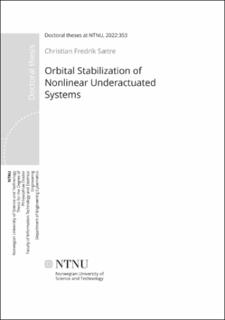| dc.description.abstract | Orbital stabilization is a particular form of set stabilization, where the control objective is to induce, via time-invariant state-feedback, an asymptotically stable orbit in the resulting closed-loop system. Here an orbit is understood as the set of all the states traced out by a solution of an autonomous system. The problem of orbital stabilization of a motion, the orbital stabilization problem, is therefore equivalent to the problem of ensuring the asymptotic orbital (Poincaré) stability of a particular solution of the controlled system. It constitutes a fundamental motion control objective, and can be formulated for a variety of different motions in terms of their associated orbits, including equilibria (trivial orbits), limit cycles (periodic orbits), point-to-point motions (heteroclinic orbits), etc.
Among the benefits of orbital stabilization is that it preserves the autonomy of the closed-loop system. It therefore has a relaxed control objective compared to trajectory tracking: Whereas a trajectory tracking controller aims to converge to an ever-evolving point in state space (i.e. a curve in time{state space), an orbitally stabilizing controller only needs to ensure convergence to the curve this point traces out in state space. This makes orbital stabilization well-suited for executing specific motions of highly nonlinear and underactuated systems, for which non-feedback-linearizable and non-minimum phase dynamics are common.
This thesis is devoted to the study of the orbital stabilization problem. It provides contributions along three main lines: 1) projection- and linearization-based methods for designing orbitally stabilizing feedback for various forced motions of a rich class of nonlinear, control-affine dynamical systems; 2) procedures for planning forced orbits of a class of underactuated mechanical systems; and 3) a technique that allows one to add a sliding mode control-based robustifying feedback extension to an existing orbitally stabilizing controller for trivial and periodic motions. A series of numerical experiments demonstrate the effectiveness of the proposed methods, including executing point-to-point maneuvers of the «butterfly» robot, generating orbitally stable symmetric walking gaits of a three-link compass biped with two degrees of underactuation, and inducing up-right oscillations in an underactuated cart-pendulum system subject to unknown perturbations. | en_US |
